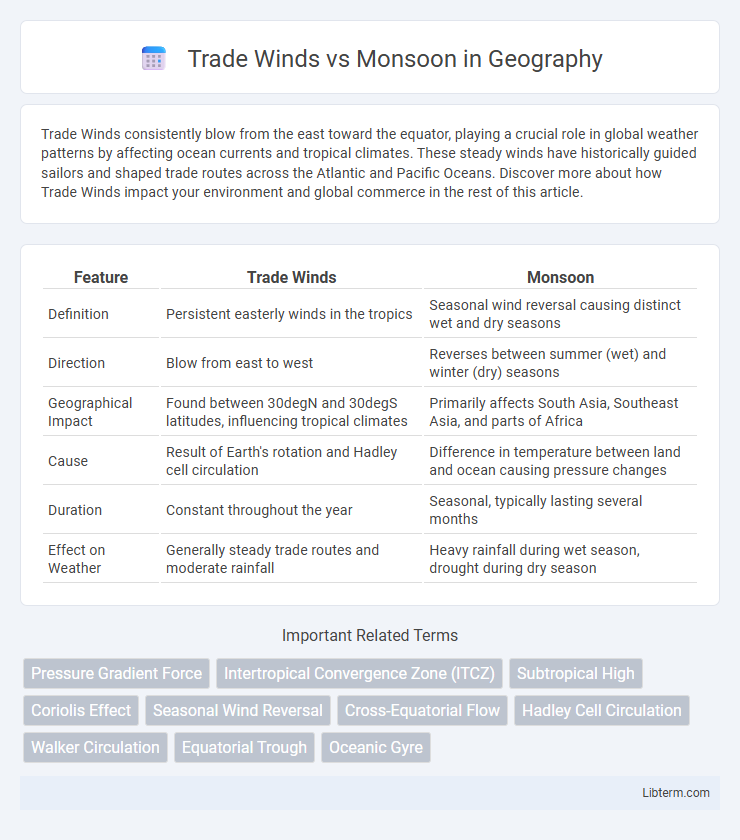Trade Winds consistently blow from the east toward the equator, playing a crucial role in global weather patterns by affecting ocean currents and tropical climates. These steady winds have historically guided sailors and shaped trade routes across the Atlantic and Pacific Oceans. Discover more about how Trade Winds impact your environment and global commerce in the rest of this article.
Table of Comparison
| Feature | Trade Winds | Monsoon |
|---|---|---|
| Definition | Persistent easterly winds in the tropics | Seasonal wind reversal causing distinct wet and dry seasons |
| Direction | Blow from east to west | Reverses between summer (wet) and winter (dry) seasons |
| Geographical Impact | Found between 30degN and 30degS latitudes, influencing tropical climates | Primarily affects South Asia, Southeast Asia, and parts of Africa |
| Cause | Result of Earth's rotation and Hadley cell circulation | Difference in temperature between land and ocean causing pressure changes |
| Duration | Constant throughout the year | Seasonal, typically lasting several months |
| Effect on Weather | Generally steady trade routes and moderate rainfall | Heavy rainfall during wet season, drought during dry season |
Introduction to Trade Winds and Monsoons
Trade winds are consistent, steady winds blowing from the subtropical high-pressure zones toward the equatorial low-pressure belt, primarily influencing tropical regions by facilitating oceanic navigation and weather patterns. Monsoons are seasonal wind systems characterized by a reverse in direction between summer and winter, driven by differential heating of land and sea, significantly affecting rainfall distribution in South Asia and parts of Africa. Both trade winds and monsoons play crucial roles in shaping regional climates, ocean currents, and ecosystems.
Definition and Origin of Trade Winds
Trade winds are steady, reliable easterly winds found in the tropics, blowing from the subtropical high-pressure areas towards the equatorial low-pressure zone. These winds originate from the Earth's rotation and the Coriolis effect, which deflects the surface air moving from the high-pressure belts at about 30 degrees latitude toward the equator. Unlike monsoons, which involve seasonal wind reversals caused by differential heating of land and sea, trade winds maintain a consistent direction and strength throughout the year.
Definition and Origin of Monsoons
Trade Winds are steady, prevailing easterly winds found in the tropics, primarily caused by the Earth's rotation and the Hadley cell circulation. Monsoons are seasonal wind patterns that result from differential heating between land and sea, leading to distinct wet and dry seasons, particularly prominent in South Asia. Originating from temperature contrasts, monsoons reverse wind direction annually, bringing heavy rainfall essential for agriculture across monsoon-affected regions.
Key Differences Between Trade Winds and Monsoons
Trade winds are steady, consistent winds that blow from the subtropical high-pressure belts toward the equator, primarily influencing tropical climate zones year-round. Monsoons are seasonal wind patterns caused by differential heating of land and sea, resulting in distinct wet and dry seasons, especially in South Asia. While trade winds maintain relatively stable directions, monsoon winds reverse direction seasonally, dramatically impacting regional weather and agricultural cycles.
Climatic Impact of Trade Winds
Trade winds are steady, prevailing easterly winds that drive ocean currents and influence tropical climate patterns by promoting dry, stable weather in subtropical regions. They play a crucial role in regulating temperature and moisture distribution, significantly impacting rainfall patterns and drought cycles in areas such as the Caribbean, West Africa, and the Indian Ocean. Unlike monsoons, which involve seasonal wind reversal and intense wet and dry periods, trade winds maintain consistent wind flow that supports maritime navigation and sustains ecosystems dependent on stable climatic conditions.
Climatic Impact of Monsoons
Monsoons significantly influence regional climates, causing seasonal shifts in wind patterns that bring intense rainfall crucial for agriculture in South Asia and parts of Africa. Unlike the steady, predictable trade winds that blow consistently from subtropical high-pressure areas toward the equator, monsoons reverse direction seasonally due to differential heating between land and ocean. This reversal triggers wet and dry seasons, profoundly impacting water resources, agriculture, and ecosystems in affected regions.
Seasonal Patterns and Variability
Trade winds maintain a consistent easterly direction due to the Earth's rotation, with minor seasonal shifts influenced by the Intertropical Convergence Zone movement. Monsoons exhibit pronounced seasonal reversals in wind direction, driven by differential heating between land and ocean, causing wet and dry phases typically over South Asia and parts of Africa. Variability in monsoons is marked by inter-annual fluctuations linked to phenomena like El Nino-Southern Oscillation, while trade winds show more stable, predictable patterns crucial for tropical weather systems.
Geographical Regions Affected
Trade Winds predominantly influence tropical regions near the Equator, including the Caribbean, Central America, and parts of West Africa, facilitating consistent weather patterns and ocean currents. Monsoons impact the Indian subcontinent, Southeast Asia, and parts of East Asia, characterized by seasonal shifts in wind direction causing distinct wet and dry seasons. While Trade Winds provide relatively stable climatic conditions, Monsoons drive significant agricultural cycles and water availability due to their dramatic seasonal variability.
Influence on Global Weather and Climate
Trade winds consistently blow from the subtropical high-pressure belts toward the equator, driving ocean currents and stabilizing tropical climates with predictable dry and wet seasons. Monsoons are seasonal wind patterns that reverse direction due to differential heating between land and ocean, causing distinct wet and dry phases that significantly impact regional agriculture and water resources. Both systems play crucial roles in shaping global weather patterns, with trade winds influencing tropical cyclone paths and monsoons driving precipitation cycles across South Asia and parts of Africa.
Economic and Environmental Significance
Trade winds drive consistent ocean currents crucial for global shipping routes, boosting international trade and economic connectivity between continents. Monsoons deliver seasonal rainfall critical for agriculture, especially in South Asia, supporting food security and rural livelihoods while also replenishing freshwater resources. Environmental impacts include trade winds influencing marine biodiversity through nutrient distribution, whereas monsoon variability can trigger floods or droughts, affecting ecosystems and economic stability.
Trade Winds Infographic

 libterm.com
libterm.com